SWITZERLAND
SPRING FESTIVAL
|
ALL ABOUT SWITZERLAND |
|
SECHSELÄUTEN SPRING FESTIVAL |
|||||
Sechseläuten · Background · Parade · Böögg Zurich Cityguide · Local History Streetparade Swiss Tour
|
Zurich's Traditional Spring FestivalSechseläuten is a traditional spring festival in Zurich, usually taking place on the third Monday in April. The main part of the event is a costume parade of the 26 guilds on Monday afternoon, followed by the symbolic ceremony of burning a cotton snowman figure, the so-called Böögg, allegorizing winter. Sechseläuten may be shifted to another date in April, however, to avoid coincidence with the easter weekend, the weekend before easter (Palm Sunday) or spring vacations of the local schools. In fact, the celebration already begins on Friday night at the Lindenhof when the official guests (every year from another Swiss canton in turn) are welcomed and brass bands are playing. Saturday night is reserved to a couple of exclusive guild balls (seems not even all guild members are admitted) while the children's parade on Sunday is open to every child wearing a historical costume.
|
Though there are several elements of older traditions present in today's festival, Sechseläuten in its current form dates back to the 19th century. In two reforms of the municipal organisation of canton Zurich in 1838 and 1866, the guilds were deprived of all their traditional political functions they had held from 1336 to 1798 and partially regained after 1815. The pompous Sechseläuten parade is in a way a reminiscence of these so-called "good old days". Sechseläuten is a public holiday in Zurich, but not in other parts of Switzerland.
The name Sechseläuten means ringing of the six'o clock (bell). Since the 16th century, the church bells have been announcing the working hours. In winter, with dusk coming early, the craftsmen had to stop working at 5 p.m., in summer they used to work until 6 p.m. Sechseläuten festivities originally were held exactly on the spring equinox (21st of March). But since working hours are individualized anyway, and the festival serves exclusively folkloristic purposes, the exact date is no longer important and more favorable weather conditions towards the end of April have turned the balance in favour of shifting the date.
In 1818 the guild zu Meisen started a first procession with riders and music during night. In 1839 all of the ancient guilds participated for the first time in a common parade. Until 1951 a series of thematic parades were being organized. The event gradually developed into a pageant at regular yearly intervals, focusing on 18th and 19th century costumes and tools. Up to today, there are about 3000 guild members marching, 350 riders on horseback and 50 horse-drawn vehicles. Some 30 brass bands are playing traditional military marches.
The route leads from the central railway station through Bahnhofstrasse to Bürkliplatz at the lake shore and back to Uraniastrasse, then crosses River Limmat on Rudolf-Brun-Brücke [the bridge dedicated to the founder of Zurich's guilds] and up Limmatquai to Sechseläutenplatz. Guild members and honorary guests are given flowers by spectators.
Unlike the big carnival parades in Basel, Lucerne and other Swiss cities, where traditional guilds are also playing a major role, you will neither find coaches drawn by tractors or trucks and stuffed with modern high-tech equipment, sound and light effects etc. nor any kind of ridicule on local or national authorities in Zurich's Sechseläuten parade.
While the children's parade is open to every child, the main pageant on Monday is reserved exclusively to members of the 26 guilds united in the Zentralkomittee der Zünfte Zürichs [Central Comittee of Zurich's Guilds]. Traditionally the guilds accepted only males as members. While some of the old guilds seem to keep up this tradition, most of the new district guilds are evidently open to women, too. A special Women's Guild, the Gesellschaft zu Fraumünster was founded in 1988 and fights for its recognition by the central committee - so far without success.
For the masses (and for national tv), the explosion of the Böögg certainly is the climax. This part of the event may have some pre-christian roots, but a there is no uninterrupted tradition. The term Böögg, was used for an awesome figure wearing a mask as early as in the 15th century. In the early 19th century boys from the Fraumünster district started burning straw dolls in spring. Since 1868 the association of district inhabitants organized a bonfire every year. In the 19th century several groups were burning their own Böögg. Since 1904 there is one central event on the Sechselätenplatz green - except during World War II when every little green space had to be used to plant potatoes.
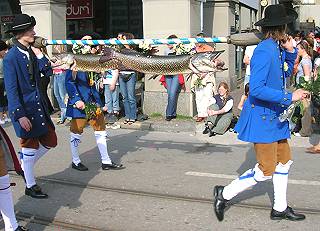 |
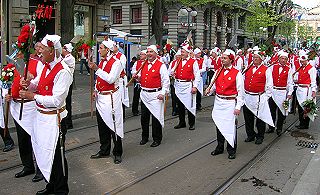 |
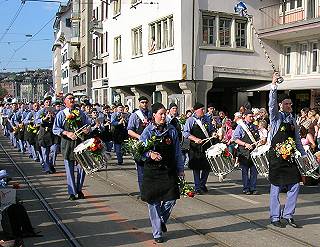 |
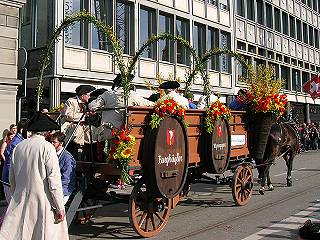 |
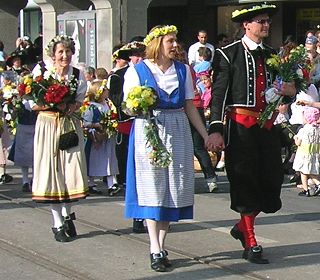 |
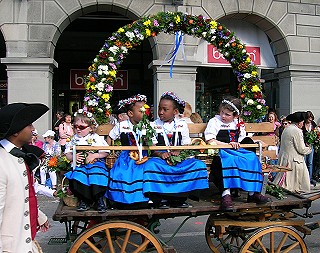 |
|
The so-called Böögg is a giant three-metre [10 ft] high effigy of a snowman made from straw and cotton wool and charged with explosives, sitting on top of a bonfire. Burning the snowman doll symbolizes putting an end to winter. Following their parade, guild members on horseback ride around the pyre while the bands are playing the official Sechseläutenmarsch tune. Of russian origin, the melody probably found its way to Zurich during the Napoleonian wars. Zurich's guild members, opposed to the revolution depriving them from their privileges, must have liked it for political reasons as much as for its musical quality. The pyre is set on fire exactly at 6 o'clock p.m. Legend has it, that the quicker the the poor Böögg "dies" (i.e. his head explodes), the sooner summer will come, the hotter it will be and the longer it will last. Depending on the humidity of the air, the riders, the photographers and the crowd may have to wait between 6 and more than 40 minutes. |
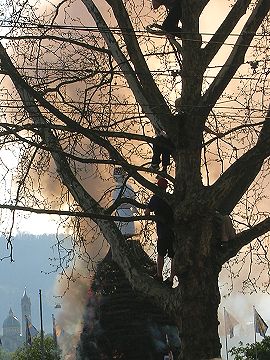 Young folks watching the agony of the poor Böögg from an old tree |
 |
Zentralkomittee der Zünfte Zürichs Central Comittee of Zurich's Guilds |

Short quotations allowed but with precise declaration of origin (Link).
Reproduction of substantial parts and pictures in printed or electronic form
only with explicit written consent by the editor.
| Disclaimer | Privacy Policy | www.all-about-switzerland.info © 2005-2010 All Rights Reserved | Editor | ||